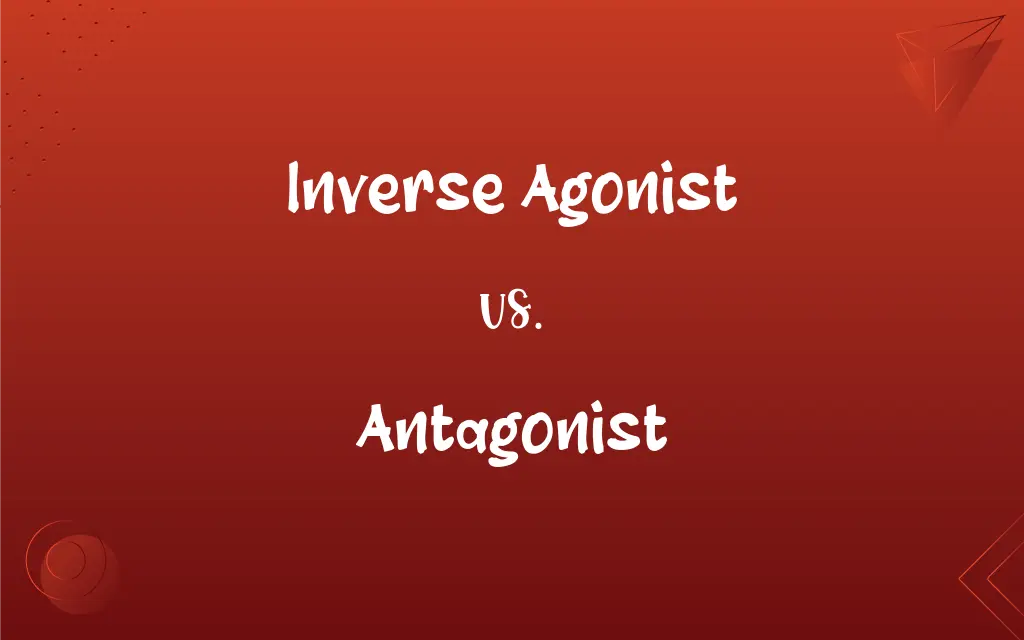Inverse Agonist vs. Antagonist: What's the Difference?
By Janet White & Harlon Moss || Published on March 29, 2024
An inverse agonist reduces the activity of a receptor beyond its basal level, while an antagonist merely blocks or dampens the receptor's response without altering its resting activity.

Key Differences
Inverse agonists bind to the same receptors as agonists but induce a pharmacological response opposite to that of the agonist, actively reducing the receptor's activity below its basal (resting) level. In contrast, antagonists also bind to receptors but do not activate them; instead, they prevent agonists from binding, stabilizing the receptor's activity at its basal level without actively decreasing it.
The action of an inverse agonist is particularly significant in systems where the receptor has constitutive (inherent) activity in the absence of a ligand, leading to a decrease in this intrinsic activity. On the other hand, antagonists are effective in systems where the presence of an agonist is required to observe an effect, simply blocking the action of these agonists without altering the receptor's resting state.
From a therapeutic perspective, inverse agonists can be useful in conditions where reducing the constitutive activity of a receptor could have beneficial effects, such as in anxiety disorders where certain receptors in the brain might be overactive. Antagonists, however, are used in a wide range of conditions to block the effects of endogenous substances or drugs, such as in hypertension where beta-blockers (antagonists) are used to block the effects of adrenaline on the heart.
The selectivity and specificity of an inverse agonist or antagonist for its receptor are crucial for its therapeutic application, with the goal of minimizing unintended effects on other receptors. This specificity allows for targeted therapy, addressing specific pathways or systems within the body without widespread disruption.
Both inverse agonists and antagonists play important roles in pharmacology and medicine, offering different mechanisms of action to modulate receptor activity for therapeutic purposes. The choice between using an inverse agonist and an antagonist depends on the desired outcome in treating a specific condition, based on the underlying pathophysiology.
ADVERTISEMENT
Comparison Chart
Mechanism of Action
Binds to a receptor and decreases its activity below basal level
Binds to a receptor and blocks agonist binding, without decreasing basal activity
Effect on Receptor
Decreases constitutive activity of the receptor
Prevents activation by agonists, stabilizes basal activity
Therapeutic Use
Used in conditions where reducing receptor activity is beneficial
Used to block undesirable effects of agonists
Example Conditions
Anxiety disorders (e.g., by targeting GABA receptors)
Hypertension, allergies (e.g., beta-blockers, antihistamines)
Selectivity
Must be highly selective to avoid reducing activity of non-target receptors
Selectivity important to prevent blocking of beneficial agonist effects
ADVERTISEMENT
Inverse Agonist and Antagonist Definitions
Inverse Agonist
An inverse agonist reduces receptor activity below its natural resting state.
Certain drugs for anxiety work as inverse agonists on the GABA receptor, decreasing nervous system activity.
Antagonist
An antagonist blocks agonists from activating a receptor without changing the receptor's basal activity.
Naloxone acts as an antagonist at opioid receptors, reversing opioid overdose effects.
Inverse Agonist
The efficacy of an inverse agonist depends on the receptor's constitutive activity level.
If a receptor is inherently active, an inverse agonist can more significantly reduce its activity.
Antagonist
It competes with agonists for receptor binding sites without activating the receptor.
Antihistamines block histamine receptors, preventing allergy symptoms.
Inverse Agonist
They are used in specific therapeutic contexts where reducing baseline receptor activity is beneficial.
Inverse agonists for the 5-HT2C receptor may be used in weight loss therapies.
Antagonist
Antagonists can be reversible or irreversible, depending on their binding mechanism.
Proton pump inhibitors irreversibly bind to their target enzyme, effectively reducing stomach acid production for an extended period.
Inverse Agonist
Inverse agonists can counteract constitutive receptor activity.
Drugs targeting the histamine H3 receptor in the brain to promote wakefulness.
Antagonist
They are widely used in treating a variety of conditions by blocking unwanted physiological responses.
Beta-blockers are antagonists that reduce heart rate and blood pressure in cardiovascular diseases.
Inverse Agonist
It binds to the same site as an agonist but has the opposite effect.
An inverse agonist at cannabinoid receptors might reduce appetite, contrasting with the agonist-induced increase in hunger.
Antagonist
Selectivity is key for antagonists to avoid blocking beneficial effects of agonists on other receptors.
Selective serotonin reuptake inhibitors (SSRIs) specifically target serotonin transporters without affecting other neurotransmitter systems.
Antagonist
One who opposes and contends against another; an adversary.
Antagonist
The principal character in opposition to the protagonist or hero of a narrative or drama.
Antagonist
(Physiology) A muscle that counteracts the action of another muscle, the agonist.
Antagonist
A drug or chemical substance that interferes with the physiological action of another, especially by combining with and blocking its receptor.
FAQs
How do inverse agonists differ from antagonists in their effect on receptors?
Inverse agonists decrease the activity of receptors below their basal level, while antagonists simply block agonists without altering the basal activity of the receptor.
Can an inverse agonist have therapeutic benefits?
Yes, inverse agonists can be beneficial in conditions where reducing the baseline activity of a receptor can alleviate symptoms, such as in certain anxiety disorders.
Can a substance act as both an inverse agonist and an antagonist?
Yes, depending on the receptor's state and the presence of endogenous or exogenous agonists, a substance may act as an inverse agonist in one context and an antagonist in another.
Are inverse agonists and antagonists always selective for one receptor type?
Ideally, both should be selective to minimize side effects, but in practice, they may have off-target effects depending on their chemical structure and the similarity between different receptor subtypes.
What determines the choice between using an inverse agonist and an antagonist in treatment?
The choice depends on the desired therapeutic outcome, the specific condition being treated, and the underlying pathophysiology.
Can antagonists be used in combination with agonists for therapeutic purposes?
Yes, antagonists can be used alongside agonists to fine-tune the activation of certain receptor systems, allowing for a more controlled therapeutic effect, such as using a beta-blocker with a cardiac stimulant in specific heart conditions.
What is an inverse agonist?
An inverse agonist is a substance that binds to a receptor and decreases its activity below the normal resting level.
What is a common use for antagonists in medicine?
Antagonists are commonly used to block the effects of agonists, such as in the treatment of hypertension, allergies, and overdose reversal.
What is the significance of constitutive activity in the action of inverse agonists?
Constitutive activity refers to the baseline activity of a receptor without a bound ligand. Inverse agonists are particularly significant in receptors with high constitutive activity, as they can decrease this baseline activity, which can be therapeutically beneficial.
How does an antagonist work?
An antagonist binds to a receptor but does not activate it, preventing agonists from binding and activating the receptor.
What role do inverse agonists play in psychiatric treatments?
Inverse agonists can play a role in psychiatric treatments by modulating neurotransmitter systems, such as reducing overactive receptor systems in anxiety disorders.
What determines the selectivity of an antagonist or inverse agonist for its receptor?
The selectivity is determined by the molecular structure of the antagonist or inverse agonist and its affinity for specific receptor subtypes, which can be influenced by the precise binding site and interaction with the receptor.
What role do inverse agonists play in drug addiction treatment?
Inverse agonists can play a role in addiction treatment by modulating the activity of receptors involved in reward pathways, potentially reducing cravings or withdrawal symptoms associated with certain addictive substances.
How is the development of resistance to antagonists and inverse agonists managed in clinical settings?
Resistance development can be managed through drug rotation, combination therapies, or the development of new drugs with different mechanisms of action to ensure continued therapeutic efficacy over time.
How do inverse agonists affect neurotransmitter systems?
Inverse agonists can decrease the activity of neurotransmitter systems by reducing the intrinsic activity of specific receptors, potentially normalizing overactive neurotransmitter systems involved in conditions like anxiety or sleep disorders.
What are the potential side effects of using inverse agonists?
Potential side effects of inverse agonists can include symptoms related to the reduced activity of the targeted receptor system, such as depression or lethargy in systems that regulate mood and energy levels.
Are there specific receptor types where inverse agonists are more commonly used?
Inverse agonists are more commonly used in receptor systems known to exhibit significant constitutive activity, such as GABA receptors in the central nervous system, which can be targets for anxiety medication.
How does receptor desensitization impact the effectiveness of inverse agonists and antagonists?
Receptor desensitization, where receptors become less responsive over time to agonist stimulation, can affect the long-term effectiveness of both inverse agonists and antagonists, potentially requiring dosage adjustments or changes in therapeutic strategy.
How do antagonists help in overdose situations?
Antagonists can rapidly displace agonists from receptors, reversing their effects, as seen with naloxone in opioid overdoses.
How do the pharmacodynamics of inverse agonists compare to those of antagonists?
The pharmacodynamics of inverse agonists involve reducing receptor activity below basal levels, which can involve complex interactions with receptor conformations, while antagonists primarily prevent receptor activation by agonists without changing the basal receptor activity.
About Author
Written by
Janet WhiteJanet White has been an esteemed writer and blogger for Difference Wiki. Holding a Master's degree in Science and Medical Journalism from the prestigious Boston University, she has consistently demonstrated her expertise and passion for her field. When she's not immersed in her work, Janet relishes her time exercising, delving into a good book, and cherishing moments with friends and family.
Co-written by
Harlon MossHarlon is a seasoned quality moderator and accomplished content writer for Difference Wiki. An alumnus of the prestigious University of California, he earned his degree in Computer Science. Leveraging his academic background, Harlon brings a meticulous and informed perspective to his work, ensuring content accuracy and excellence.
































































